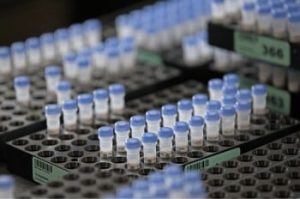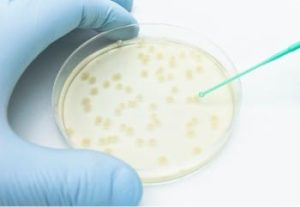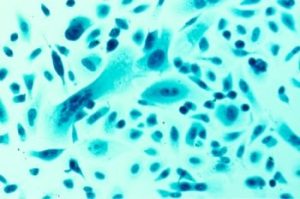Antisense oligonucleotides, or ASOs, are 15–22 nt DNA sequences designed to bind complementary RNA targets, ultimately facilitating their degradation. ASO technology provided the first oligonucleotide-based approach to disrupting gene expression and has been used in knockdown experiments, target validation, drug therapy, and other applications [1]. More recently, ASOs are used to study the role of long noncoding RNAs (lncRNAs) in gene regulation. Many lncRNAs are localized to the nucleus [2]. Often, lncRNA loss-of-function studies use techniques, such as RNAi, that are less effective because the nucleus contains a low amount of the required enzymes. ASOs, however, are particularly useful for studying nuclear lncRNAs, because ASOs engage RNase H—an enzyme prevalent in the nucleus that binds and cleaves DNA/RNA heteroduplexes. IDT scientists have done extensive research on this application [3-5]. See references 3-5 below for publications describing their findings. RNase H1 is an endogenous endonuclease that binds DNA/RNA heteroduplexes and cleaves the RNA strand, leading to degradation. For its action, cellular RNase H1 requires the heteroduplex to contain a segment of unmodified (with either native or phosphorothiate linkages) DNA that is ≥6 bases.
Modifications providing in vitro stability
We recommend modifying your ASO sequence for increased stability and binding affinity. A commonly used modification is the phosphorothioate (PS) bond which can be added throughout the oligonucleotide backbone to provide stability against nucleases [6]. Of note, PS bonds can enable the ASO to bind non-specifically to proteins which can improve ASO uptake and increase in vivo circulation time, but can also increase toxicity [7]. Toxicity from PS bonds can be diminished with the addition of some 2’-ribose modifications such as 2’-O-methyl (2’OMe) or 2’-O-methoxyethyl (2’MOE), or by strategically reducing the number of PS bonds in the ASO [1,7,8]. The addition of PS linkages also reduces the binding affinity of the ASO to the target RNA [6]. This can be offset by including higher binding affinity modifications (e.g. 2’OMe, 2’MOE or Affinity Plus™ locked nucleic acids) in a “gapmer” design where blocks of these modifications surround a DNA core required for RNase H1 recognition (see example below). ASOs with these modifications display more nuclease resistance, lower toxicity, and increased hybridization affinities within cells and in vivo, compared to unmodified DNA.
Ordering modified ASOs
To have phosphorothioate bonds added to your sequence, use an asterisk “*” between the bases.
Examples: Hs HPRT 2’MOE ASO-1353 /52MOErG/*/i2MOErC/*/i2MOErT/*/i2MOErG/*/i2MOErA/*C*A*A*A*G*A*T*T*C*A*/i2MOErC/*/i2MOErT/*/i2MOErG/*/i2MOErG/*/32MOErT/ Hs HPRT Affinity Plus ASO-849 +A*+G*+G*A*C*T*C*C*A*G*A*T*G*+T*+T*+T
These oligos can be ordered with standard desalt or HPLC purification with Na+ salt exchange. The Na+ salt exchange is necessary to remove toxic salts from HPLC purification.
Click here to order IDT Antisense Oligonucleotides.
References
1. Crooke ST, Liang XH, Baker BF, Crooke RM. Antisense technology: A review. J Biol Chem. Jan-Jun 2021;296:100416. doi:10.1016/j.jbc.2021.100416
2. Bridges MC, Daulagala AC, Kourtidis A. LNCcation: lncRNA localization and function. J Cell Biol. Feb 1 2021;220(2)doi:10.1083/jcb.202009045
3. Lennox KA, Behlke MA. Cellular localization of long non-coding RNAs affects silencing by RNAi more than by antisense oligonucleotides. Nucleic Acids Res. Jan 29 2016;44(2):863-77. doi:10.1093/nar/gkv1206
4. Lennox KA, Behlke MA. Tips for Successful lncRNA Knockdown Using Gapmers. Methods Mol Biol. 2020;2176:121-140. doi:10.1007/978-1-0716-0771-8_9
5. Lennox KA BM. Mini-review: Current strategies to knockdown long non-coding RNAs. J Rare Dis Res Treat. 2016;1(3):66-70.
6. Wan WB, Migawa MT, Vasquez G, et al. Synthesis, biophysical properties and biological activity of second generation antisense oligonucleotides containing chiral phosphorothioate linkages. Nucleic Acids Res. Dec 16 2014;42(22):13456-68. doi:10.1093/nar/gku1115
7. Crooke ST, Vickers TA, Liang XH. Phosphorothioate modified oligonucleotide-protein interactions. Nucleic Acids Res. Jun 4 2020;48(10):5235-5253. doi:10.1093/nar/gkaa299
8. Tran H, Moazami MP, Yang H, et al. Suppression of mutant C9orf72 expression by a potent mixed backbone antisense oligonucleotide. Nat Med. Jan 2022;28(1):117-124. doi:10.1038/s41591-021-01557-6
For research use only. Not for use in diagnostic procedures. Unless otherwise agreed to in writing, IDT does not intend these products to be used in clinical applications and does not warrant their fitness or suitability for any clinical diagnostic use. Purchaser is solely responsible for all decisions regarding the use of these products and any associated regulatory or legal obligations. Doc ID: RUO22-1195_001























